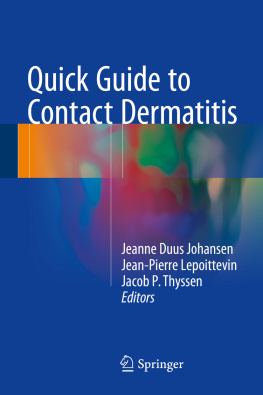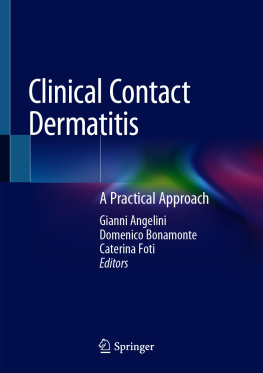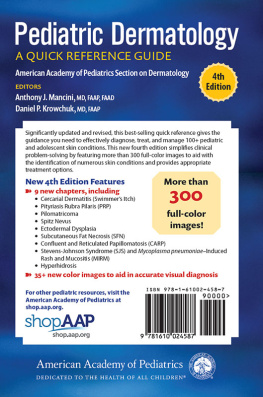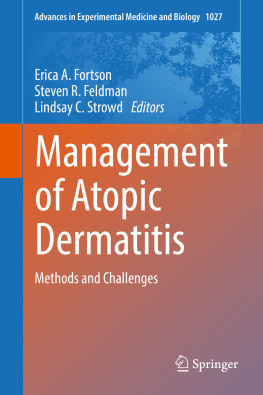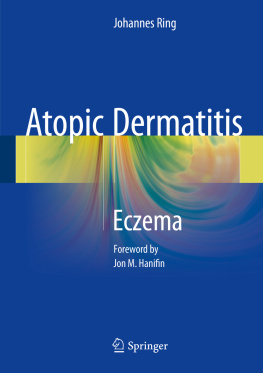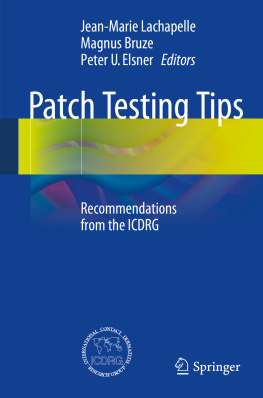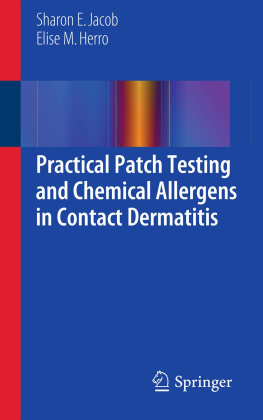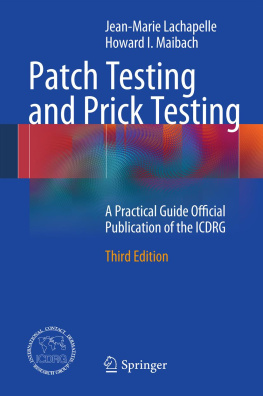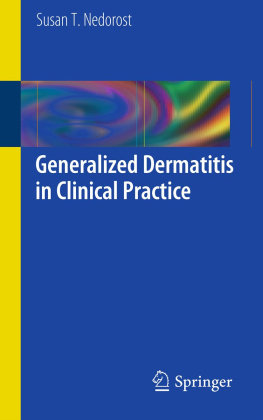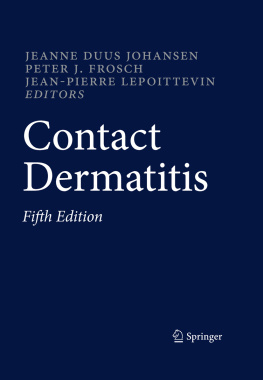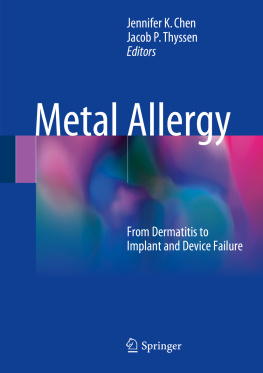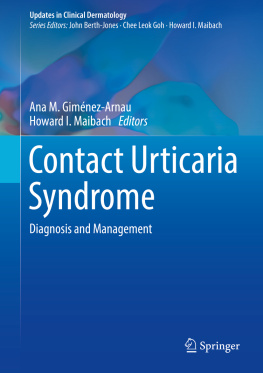Part I
General Aspects
Springer-Verlag Berlin Heidelberg 2016
Jeanne Duus Johansen , Jean-Pierre Lepoittevin and Jacob P. Thyssen (eds.) Quick Guide to Contact Dermatitis 10.1007/978-3-662-47714-4_1
1. Immunological Background of Allergic Contact Dermatitis
Thomas Rustemeyer 1
(1)
Department of Dermatology and Allergology, VU University Medical Center, De Boelelaan 1117, Amsterdam, 1081 HV, The Netherlands
Keywords
Immunology T cell Dendritic cell Langerhans cell Irritancy Contact allergen Skin barrier Cytokine Local skin memory Immunological tolerance
Abbreviations
APC
Antigen-presenting cells
CCR
C-C chemokine receptor
CD
Classification determinant
MHC
Major histocompatibility complex
TGF-
Transforming growth factor-
1.1 Introduction
Allergic contact dermatitis is an acquired immunological inflammation in response to contact with specific allergens which are recognized by pro-inflammatory T cells. The majority of contact allergens are small molecules which can penetrate the epidermal barrier. In the skin, dendritic cells can pick up the allergen and present it on their cellular surface in the context of MHC class I and/or class II molecules. The release of unspecific danger signals facilitates the activation of dendritic cells. This allows for the maturation of allergen-presenting dendritic cells in the epidermis and dermis. The activated and fully matured dendritic cells migrate to the draining lymph nodes and present the allergen to T cells. They start to proliferate and form effector cells, which can get activated upon contact to their specific allergen. From now on, allergen contacts can induce allergen-specific T-cell-mediated immune responses with the clinical picture of allergic contact dermatitis. In the following sections, all major immunological events will be discussed (Fig. ).

Fig. 1.1
Major immunological events in allergic contact dermatitis. In the induction phase of allergic contact dermatitis ( left side of the drawing), skin contact with a contact allergen triggers migration and maturation of antigen-presenting cells ( APC ). These cells reach via the afferent lymphatic vessels the regional skin-draining lymph node. Allergen-presenting dendritic cells home into the T-cell-rich paracortical areas. Here, local conditions are optimal for encountering naive T cells that recognize allergenMHC molecule complexes. During T-cell priming, hapten-specific T cells strongly proliferate and generate effector and memory cells, which are partly released into the circulation. Renewed allergen contact leads to the elicitation reaction (shown at the right side ). Allergen-specific effector T cells are triggered to produce pro-inflammatory cytokines. Thereby, more inflammatory cells are recruited to the allergen contact site which results in strong local inflammatory mediator release. This leads to a gradually increasing inflammatory reaction, reaching a maximum within one to few days, after which reactivity successively declines ( Kanervas Occupational Dermatology , 2012 Editors: Thomas Rustemeyer, Peter Elsner, Swen-Malte John, Howard I. Maibach et al. Springer-Verlag Berlin Heidelberg 2012, with Permission of Springer Science+Business Media)
1.2 Allergens
Most of the contact allergens are small and chemically reactive molecules not exceeding a molecular weight of 800 Dalton. Due to their size, they can penetrate through the epidermal barrier. In the epidermis and dermis, they can react with endogenous peptides and form immunologically relevant allergen-carrier complex. For some allergens, an enzymatic of metabolic activation step is needed to generate the actual allergen.
In principal, all contact allergens have to a certain extent irritant properties. This irritancy can add to the allergenic potency by triggering the release of innate danger signals from immune cells.
1.3 Antigen-Presenting Cells
In the epidermis and dermis are different types of professional antigen-presenting dendritic cells. Their common feature is the capacity to pick up and present antigens to other cells of the immune system. The epidermal antigen-presenting cells are called Langerhans cells, and the dermal types are summarized as dermal dendritic cells. Upon contact with contact allergens, dendritic cells get activated. The release of pro-inflammatory danger signals from surrounding cells or directly from the dendritic cells amplifies this activation. Under the inflammatory pressure, dendritic cells get fully matured and start to emigrate from (epi)dermal structures via the lymphatic vessels toward the draining lymph nodes. Here, they get attracted by chemokines binding to the chemokine receptor CCR7, which is expressed on the cellular surface of matured dendritic cells. This allows antigen-presenting cells to settle in the subcapsular compartments of the draining lymph nodes.
1.4 Priming of Allergen-Specific T Cells
In the draining lymph nodes, naive T cells can extravasate from capillaries and patrol in the subcapsular compartments. If they encounter properly presented antigen which fits in the groves of their specific T-cell receptors, they get the first signal for getting activated (antigen-specific signal). If the antigen is presented in the context of MHC class I molecules on the surface of the dendritic cell, then CD8+ T cells do recognize it. In analogy, presentation of antigen by MHC class II molecules results in the recognition by CD4+ T cells. The second signal consists of sufficient interaction of co-stimulatory cell membrane-bound signals of both matured dendritic cells and naive T cells (receptor-mediated co-stimulatory signal). These two signals stimulate the priming of allergen-specific T cells from the naive state into the antigen-experienced state. The primed T cells start to proliferate, which can result in swelling of the lymph node. The presence of soluble immunological mediators in the microenvironment of the T cells can skew developing T cells toward distinct effector subtypes (third signal: cytokine-driven T-cell skewing). These local cytokines are generated by antigen-matured dendritic cells and by resident stromal cells of the lymph node. As a consequence, the generating allergen-specific T cells can either become pro-inflammatory cells or immunoregulatory T cells. The first T-cell types can be subdivided into Th1 cells, characterized by the production of IFN- in particular; Th2 with a predominant production of IL-4, IL-5, and IL-13; and Th17 with high IL-17 and IL-23 production. The latter T cells have immunoregulatory properties and can either actively suppress pro-inflammatory reactions, then they are called suppressor T cells or cause antigen-specific tolerance. These cells are characterized by the release of immunosuppressive/-regulatory cytokines such as IL-10 and TGF-. Furthermore, a subset of primed T cells keep homing receptors to settle in the draining lymph node. These cells express CCR7 and bind their ligand CCL19 expressed in the subcapsular compartment. They form the long-term immunological memory and are called central memory T cells. In contrast, CCR7- T cells have to leave the lymph node and become peripheral effector/memory T cells. These T cells recirculate in the blood and control peripheral tissues. In summary, during the priming of allergen-specific T cells, functionally different subsets can develop. These subsets determine the immunological outcome and clinical appearance of the elicitation reaction in allergic contact dermatitis.

